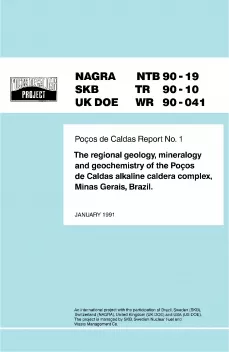
Technical Report NTB 90-19
The regional geology, mineralogy and geochemistry of the Poços de Caldas alkaline caldera complex, Minas Gerais, Brazil.
The Poços de Caldas alkaline complex, the largest in South America, is circular-shaped with a mean diameter of about 33 Ian. It is one of the Mesozoic alkaline occurrences of south-eastern Brazil that developed from the Upper Jurassic onwards, during continental break-up and drift. It comprises a suite of alkaline volcanic and plutonic rocks (mainly phonolites and nepheline syenites) with normal background amounts of U, Th and rare-earth elements (REEs). The evolutionary history began with major early volcanism involving ankaratrites, phonolite lavas and volcanoclastics, followed by caldera subsidence and nepheline syenite intrusions forming minor ring dykes, various intrusive bodies and circular structures. Finally, eudialyte nepheline syenites, and phonolites, strongly enriched in incompatible elements, were emplaced.
Magmatic evolution included deuteric processes, indicating a volatile-rich parent magma. These processes extended over a large temperature range and resulted in the formation of pegmatitic veins and pneumatolytic and auto-hydrothermal mineral assemblages including rare metal silicates such as giannettite, various zeolites, fluorite and hematite, together with mineral alterations. These alterations developed from magmatic pseudoleucite through alkali-exchange reactions to a "clouding" of the main alkali feldspars under auto-hydrothermal conditions (with fluid inclusion formation, incipient kaolinization and hematite-hydrous ferric oxide pigmentation). Geochemically, the resulting rocks are enriched in potassium when compared to global nepheline syenites and phonolites. Mobilization and concentration of U, Th and REEs could not be detected at this stage.
At least at one location (Morro do Ferro) the intermediate nephelinic suite was affected by a carbonatite intrusion and the formation of a stockwork of magnetite veins.
Very intensive hydrothermal K- and S-rich alteration, associated with penecontemporaneous formation of magmatic breccias, occurred locally.
These processes led to the formation of several important radioactive and REE-rich anomalies. Two of these, the Th-REE occurrence of Morro do Ferro and the U-Zr-REE-Th occurrence of the Osamu Utsumi uranium mine, comprise the study sites of the Poços de Caldas Analogue Project.
Later major evolutive stages of the Poços de Caldas complex involved the emplacement of mafic-ultramafic dyke rocks and the onset of lateritic and allitic weathering, resulting (at the uranium mine) in supergenic geochemical redistribution and the formation of redox fronts sometimes related to uranium enrichments.
The regional rock studies were focussed on the "status quo" properties of the intermediate nephelinic suite with respect to the subsequent more local hydrothermal and final weathering-related processes. They included petrographic, mineralogical, geochemical and isotopic studies, in addition to petrophysical parameters. Results showed very little variation for the studied intrusive, subvolcanic and volcanic nepheline syenites and phonolites. The lack of a major differentiated series may be seen as an argument for a short emplacement history of the intermediate nephelinic suite. Previous and present radiometric age measurements suggest a time span of about 15 Ma for emplacement, much too long if compared to modern volcanoes. The end of the magmatic and hydrothermal-mineralizing events is likely fixed by the Ar-Ar dating of an unmineralized lamprophyre dyke intrusion at the site of the uranium mine (76 Ma).
